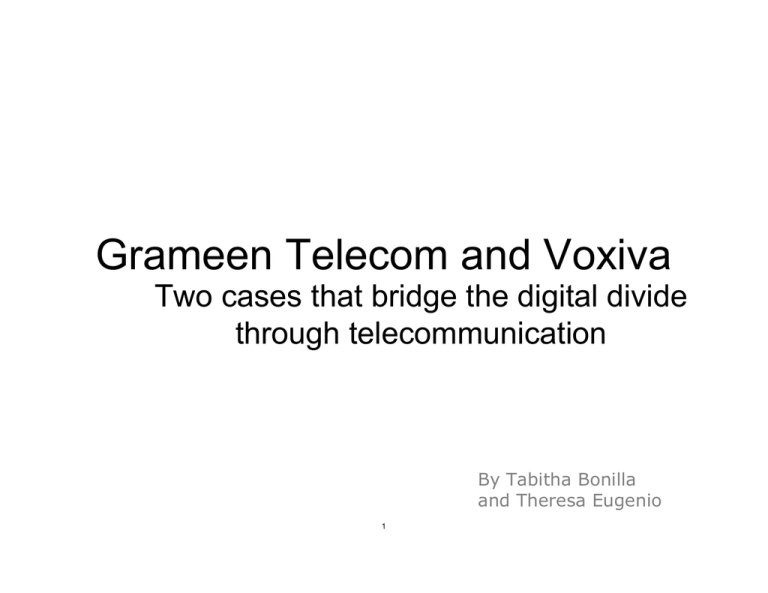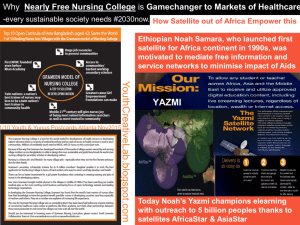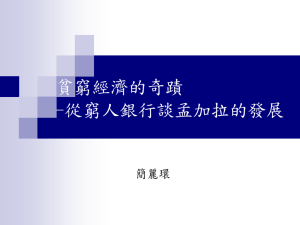Grameen Telecom and Voxiva Two cases that bridge the digital divide
advertisement

Grameen Telecom and Voxiva Two cases that bridge the digital divide through telecommunication By Tabitha Bonilla and Theresa Eugenio 1 Outline • Grameen Phones – Telephone connectivity in Bangladesh – Introducing phone systems to rural villages • Voxiva – Healthcare concerns in Peru – Producing a system that promotes more urgent care 2 Case 1: Grameen Village Phone Program • Problem – 97% of Bangladesh homes have no telephone – 0.34 telephone lines per 100 people – 2 day trip to make a call 3 Grameen Solution • Twofold 1. Non-profit Grameen Telecom (GT) 2. For-profit Grameen Phone (GP) • Both branches of Grameen bank 4 Grameen Telecom • Village Phone Program – Started in 1997 – Pay-per-call system – Gives villages easily accessible mobile phone stations – Grameen Bank provides loans and training 5 GT Benefits • Financial – City calls cost 1.94 to 8.44 times as much – 2.64% to 9.8% of monthly income – 86% of calls used for financial purposes – 8% used explicitly to improve prices • Social – Empowers village women 6 Grameen Phone • National mobile phone service – Won license in 1996 – Began operations on March 26, 1997 – Primarily urban areas – Individually-owned systems 7 GP-GT Interaction • Demonstrates how complementary profit and non-profit organizations feed into one another • GP profits offset GT costs » -allows GT calls to be 50% off • Economic growth could lead to an eventual rise in GP customers 8 Measures of Success-GT • 165,000 subscribers as of August 2005 • Low cancellation rate- 2.18% 9 Measures of Success-GP 10 • About 63% of mobile phone market in 2000 Reasons for Success • Gives people a sense of ownership rather than charity • Grameen provides a strong support system after the initial startup – Gives a sustaining power that many other projects lack • Already connected with the necessary business infrastructure – GB handles finances, GP subsidizes • Versatility 11 Obstacles • Government bureaucracy – BTTB unwilling to increase accessibility to network – Exorbitant fees to add lines • Local management – Unwilling to work with poor credit ratings – Unwilling to risk good credit ratings 12 Other Applications • Would this system work in other areas? – If so, where? If not, how would it have to be modified? • Is the for-profit/non-profit coupling feasible in the long run? • What other industries could implement this system? 13 Case 2: Voxiva • Voxiva focuses efforts on extending technology beyond the digital divide primarily through telecommunication • A for profit organization set up in 2001 to look into voice and data solutions • Because of the lack of internet resources, decided to target telephones, a market that makes under $2 per day 14 ALERTA • Local users give their information via phone or internet Image removed due to copyright reasons. • Government receives information and distributes healthcare as needed 15 ALERTA Services Card Image removed due to copyright reasons. 16 Health Concerns • 68% of childhood deaths and 48% of premature deaths are caused by infectious diseases • 300 million people have acute cases of malaria • More than 500,000 women die from pregnancy and childbirth complications a year 17 Health Concerns • Infectious diseases such as HIV/AIDS, malaria, and cholera account for half of all deaths in developing countries • The rural poor are disproportionately affected due in large part to poor communication between the affected areas and domestic and international health agencies, without which officials cannot control the spread of infectious disease 18 Economic concerns Image removed due to copyright reasons. 19 Fighting human disease • Infectious diseases are a threat in both human and economic terms • Early detection is critical and requires active surveillance • Relevant action reduces the probability the disease will spread • Requires the ability to communicate quickly and easily between effected groups and authorities 20 Communication Limitations • Internet access is extremely limited • 70% of the world’s poor have limited access to telecommunication 21 Voxiva • Before Voxiva, Paul Meyer founded IPKO, the first and largest internet provider in Kosova • Learned: 1. Most projects are not scalable 2. Donors suffered from “dot-com” fever 3. Narrow focus on the internet as a solution is significant 22 Case Study: Peru Image removed due to copyright reasons. 23 Health Concerns: Peru • In Ucayali region: – Infant mortality rate is 52 per 1000 compared to 34 per 1000 nationally – Maternal death rate was 185 per 100,000 compared to the national rate of 146 per 100,000 24 Transportation complications • Medical facilities are difficult to reach via land due to the dense Amazon forest • Travel by river can take from 2 to 7 days to reach the desired destination • Inability to reach medical facilities reduces the chance of early detection and the ability to treat quickly 25 Healthcare in Peru • 6,000 health centers across Peru – Each required to report cases of disease • Ministry of Health investigates and takes action • System currently maintained is paper based with computers at the top end of the health service – Results in a 3-week delay 26 Healthcare in Peru • More than 90% of healthcare providers reported receiving health alerts “never,” “rarely” or “less than once a month” • Peruvian Ministry of Health also wanted to update its present surveillance system • The Regional Health Directorate wanted to reduce the occurrence of infectious disease in rural Peru by about 50% 27 Objectives in Peru 1. Expand the network of health posts 2. Form a more efficient feedback loop 3. Improve data quality 4. Reduce amount of time spent on paper work 28 Solution • Voxiva connected 204,000 individuals in two rural districts • System incorporated 76 health clinics, health centers and district centers • Voxiva’s reports are always available in realtime through text messaging or email 29 Information Flow in Epidemiologic Surveillance Image removed due to copyright reasons. 30 Results: Efficiency • Trained 149 users and counterparts in 76 health facilities • Demonstrate that it is feasible to do real time electronic disease and disaster reporting • Health authorities have been able to receive information and respond in hours or days instead of weeks 31 Benefits of ALERTA 1. Allows for two-way communication 2. Simplifies coordination among the different management and operation levels concerned with disease management and operation levels 3. Provides a unique database, for real-time and historical analysis 4. Reduces errors and increases efficiency 5. Permits exporting the data to PDF, Excel and other formatting 32 ALERTA Pilot Score Card Goals Grade Technically Appropriate and Feasible B+ Cost-Effective A+ Can be maintained with local skills and resources A- Acceptable by Clients and Providers A- Results in Favorable Effects on Health 33 TBD Challenges • Lack of telephones can be a major constraint – Radios have been recognized as sustainable way to support the rural telephony network • High turnover of government personnel requires the project to seek new supporters, and orient new participants in a very short period 34 Other effects • Using existing phones reduces the cost of a communication system by an average of 40%, requires minimal training, and allows for a faster and more appropriate response • 87% of rural healthcare workers with access to a phone called in regularly • 90% reported faster responses from supervisors • 70% believed the system had improved communication • Examples: – Measles case – Transportation case 35 Primary Market Needs 1. Environment and deployable resources determine the market used 2. Provide a real-time assessment of field situations will help prevent or decrease the duration of outbreaks 3. System increases quality and quantity of data that affects decision making 36 Primary Market Needs 4. System must be cost effective 5. Technology must facilitate adoption and use 6. Collaboration drives problem solving 7. Significantly increased communication through staff meetings 8. Industries standards must be adhered to 37 Extensions in developing countries • Has been used crime reporting by civilians • Enables some bank customers to access their balances and check bill payments across the phone • Voxiva also looking to partner with development institutions to expand program to Brazil, Rwanda, South Africa and India 38 Extensions in the United States • Currently being used by the US military to help combat disease in Iraq • The FDA is now testing the same system used in Peru to monitor the US blood supply • The Defense department is using the system to monitor their small pox vaccination program • It is also being introduced in San Diego County and Washington, DC to link school nurses with local health departments 39 Source Citations • http://www.voxiva.net/nacer.asp • http://www.sustainableicts.org/infodev/Voxiva.pdf • http://www.markle.org/markle_programs/project_archives/2001/gdop_v oxiva.php • http://www.omidyar.net/corp/p_vox.shtml • http://www.acumenfund.org/Work/HealthTechnology/voxiva.asp • http://www.grameenphone.com 40 MIT OpenCourseWare http://ocw.mit.edu 21G.034 / CMS.930 Media Education and the Marketplace Fall 2005 For information about citing these materials or our Terms of Use, visit: http://ocw.mit.edu/terms.


